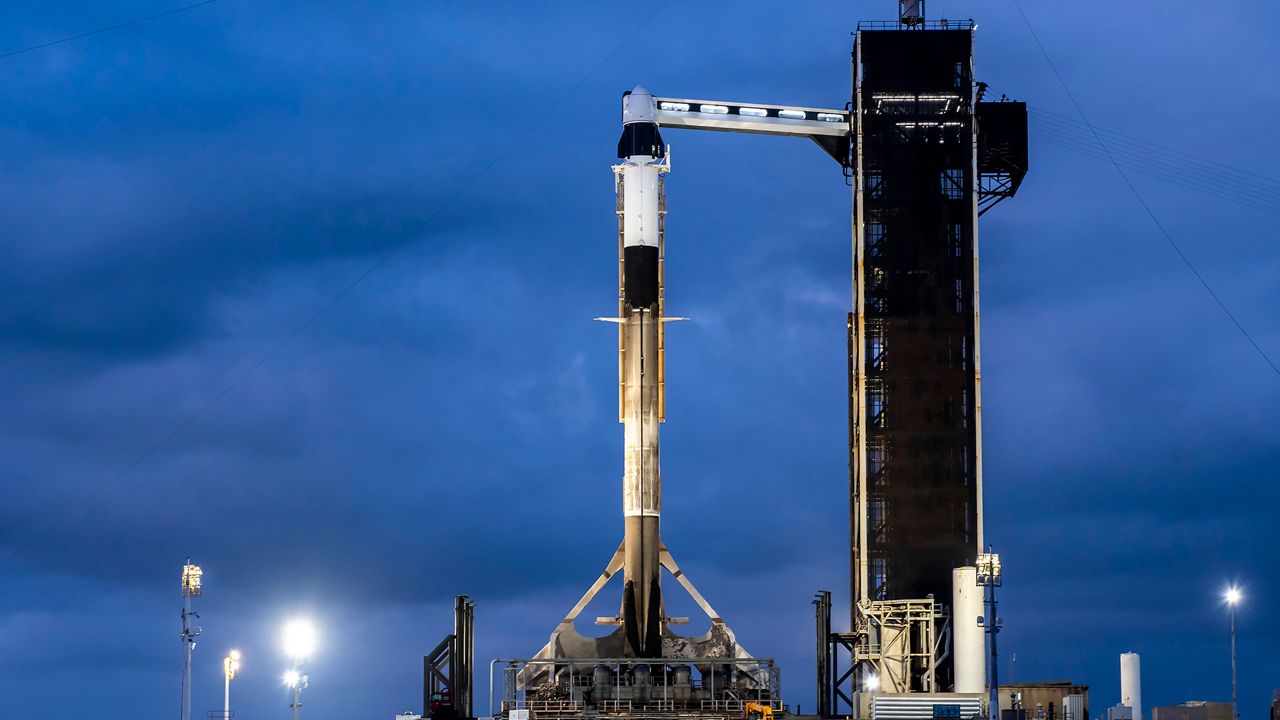KENNEDY SPACE CENTER — NASA and SpaceX successfully launched four crew members into space early Wednesday aboard a Falcon 9 rocket for a six-month mission on the International Space Station.
What You Need To Know
- Four crew members were launched Wednesday aboard the Dragon spacecraft Freedom to the ISS
- They will remain aboard the ISS for a six-month mission
- Scroll down to see the photo gallery and re-watch the launch
The Crew-4 members were aboard the Dragon spacecraft Freedom, which sat on top of a Falcon 9 rocket at Launch Complex 39A at the Kennedy Space Center. Liftoff was at 3:52 a.m. EDT.
About the mission
This is the first flight for the Dragon spacecraft named Freedom, which is nearly 27 feet tall and can carry seven people to orbit.
The Falcon 9 first-stage booster has completed other missions, including the Crew-3 mission in November of 2021. The nearly 230-foot-tall rocket sent the Dragon spacecraft into space at the incredible speed of 17,500 mph to put it on course with the ISS.
To reach those speeds, the Falcon 9 has nine SpaceX Merlin engines holding 50,265 pounds of fuel to power them.
After the stage separation, the Falcon 9’s first stage landed on the droneship “A Shortfall of Gravitas” in the Atlantic Ocean.
Ahead of the countdown, the 45th Weather Squadron gave a 90% chance of favorable weather for the launch.
Mark Burger, 45th Weather Squadron launch officer, said that the weather was not an issue for this mission while explaining to Spectrum News how it can impact space travel.
Leading up to the @SpaceX-@NASA launch of the #Crew4, weather plays a part. Mark Burger of the #45thWeatherSquadron takes the time to explain that, the weather impact of the @Axiom_Space mission and when the #Crew3 will return.
— Anthony Leone (@AnthonyLeone) April 27, 2022
Get more with @MyNews13 https://t.co/zGKIr2br1h pic.twitter.com/0Ty84CdFY4
And the Crew-3 and Crew-4 will get to spend a little time together.
“Following docking of Crew-4, NASA’s SpaceX Crew-3 mission is expected to complete an approximate five-day handover with Crew-4 before undocking from the space station and returning to Earth,” NASA said on its website.
During the course of their six-month mission, the crew members will be conducting more than 200 science experiments — including health technologies and plant science — and maintenance before returning to Earth in the fall of 2022, according to NASA and SpaceX.
Patrick O'Neill, the public affairs manager for the International Space Station U.S. National Laboratory, explained the importance of some of those experiments.
"The fact that you know they will be on station now for six months means they will be in a position to go out there and conduct hundreds of research investigations," he said. "They can bring value to humanity as well as drive business models to low Earth orbit."
He explained more to Spectrum News in the video below:
🚀 Patrick O’Neill of the #InternationalSpaceStation U.S. National Laboratory talks about the importance of the experiments that the @NASA-@SpaceX’s #Crew4 will be doing on the @Space_Station.
— Anthony Leone (@AnthonyLeone) April 27, 2022
Go to @MyNews13 to learn more about the mission. https://t.co/zGKIr2br1h pic.twitter.com/6hIUX8zOSR
This is not the first time the space company and space agency have come together for missions. While the joint SpaceX-NASA Demo-2 mission was a short-term one, the previous Crews 1, 2 and 3 missions have been long-term endeavors.
Even other launches like, SpaceX's Inspiration4 and the Axiom Space's Ax-1, have proven to be a wealth of knowledge for the NASA-SpaceX missions.
Meet the Crew-4
Crew-4 astronauts, SpaceX, and @NASA completed a full rehearsal of launch day activities pic.twitter.com/b6AtNdJMxT
— SpaceX (@SpaceX) April 20, 2022
The mission is made up of three NASA astronauts: Dr. Kjell Lindgren, MD, who is the mission commander and has been with NASA since being selected in 2009.
Robert Hines is the pilot for this mission and was selected by NASA to join the 2017 Astronaut Candidate Class. Before that, he was with the United States Air Force for more than 21 years as a fighter pilot, test pilot and instructor pilot.
Dr. Jessica Watkins was also picked by NASA to join the 2017 Astronaut Candidate Class and is a mission specialist. She is a geologist and conducted her graduate research on the impacts of landslides on Mars and Earth.
The fourth member is European Space Agency astronaut Samantha Cristoforetti, who is also a mission specialist. Before joining the ESA in 2009, she was a fighter pilot.
While she has spent time on the ISS and conducted other space missions, she also served two years on the ESA’s Gateway project, which will be a spaceship that will be used to orbit the moon.
David Parker, the European Space Agency's director of Human and Robotic Exploration, spoke to Spectrum News about the role Cristoforetti has on the Crew-4 mission.
"Well, Samantha is continuing our big program of science," he said. "Some of the science is preparing us to go further into deep space and some of it is really useful back here on Earth. So, one of the experiments is related to the effects of aging, the radiation environment in space and how we can counteract that through our research activities."
🚀 I spoke with David Parker, @esa's director of Human and Robotic Exploration. He talks about what made @SpaceX-@NASA’s #Crew4 launch special for him, what Samantha Cristoforetti will be doing and gives advice to kids who want to go into space. https://t.co/zGKIr2br1h pic.twitter.com/1JsdrgK4oH
— Anthony Leone (@AnthonyLeone) April 27, 2022
Crew-4 photo gallery









